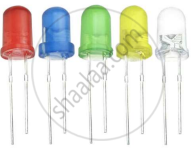Advertisements
Advertisements
Question
Sunil and his parents were travelling to their village in their car. On the way his mother noticed some grey coloured panels installed on the roof of a low building. She enquired from Sunil what those panels were and Sunil told his mother that those were solar panels.
(a) What were the values displayed by Sunil and his mother? State one value for each.
(b) In what way would the use of solar panels prove to be very useful?
(c) Name the semiconductor device used in solar panels. Briefly explain with the help of a diagram, how this device works
Solution
(a) The value displayed by Sunil is awareness and the value displayed by Sunil's mother is curiosity.
(b) The use of solar panels would prove to be useful because
- It harnesses solar energy that is free from all kinds of pollution. Thus, they are eco-friendly.
- It is highly durable and, hence, requires no maintenance.
(c) Semiconductor device used in solar panels is solar cell.
It is a semiconductor device used to convert photons of solar light into electricity.
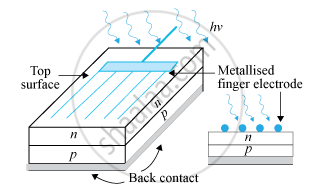
It generates emf when solar radiation fall on the p-n junction.
-
A p-type silicon wafer of about 300 μm is taken over which a thin layer of n-type silicon is grown on one side by diffusion process.
-
The generation of emf by a solar cell when light falls on it is due to following three processes:
-
The light close to the junction generates e-h pairs.
-
The electric field of the depletion region separates the electrons and holes.
-
The electrons reaching the n-side are collected by the front contact, while the holes reaching the p-side are collected by the back contact. Thus, the p-side becomes positively charged and the n-side becomes negatively charged, giving rise to photovoltage.
-
- Semiconductors with band gaps close to 1.5 eV are ideal materials for the fabrication of solar cells.
- V-I characteristic of a solar cell:
The V-I characteristic of a solar cell as follows:
Isc is the short-circuit current when the load resistance RL is zero.
Voc is the open-circuit voltage when RL is infinity.
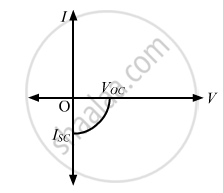
APPEARS IN
RELATED QUESTIONS
Using the necessary circuit diagrams, show how the V-I characteristics of a p-n junction are obtained in
Forward biasing
How are these characteristics made use of in rectification?
The width of depletion region of p-n junction diode is _______.
(A) 0.5 nm to 1 nm
(B) 5 nm to 10 nm
(C) 50 nm to 500 nm
(D) 500 nm to 1000 nm
Why is zener diode fabricated by heavily doping both p- and n-sides of the junction?
Briefly explain its working. Draw its V - I characteristics for two different intensities of illumination ?
Show the output waveforms (Y) for the following inputs A and B of (i) OR gate (ii) NAND gate ?
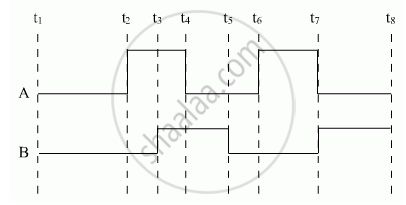
What happens to the width of depletion player of a p-n junction when it is (i) forward biased, (ii) reverse biased?
The plate resistance of a triode is 8 kΩ and the transconductance is 2.5 millimho. (a) If the plate voltage is increased by 48 V and the grid voltage is kept constant, what will be the increase in the plate current? (b) With plate voltage kept constant at this increased value, by how much should the grid voltage be decreased in order to bring the plate current back to its initial value?
What is a solar cell?
Read the following paragraph and answer the questions.
|
LED is a heavily doped P-N junction which under forward bias emits spontaneous radiation. When it is forward-biased, due to recombination of holes and electrons at the junction, energy is released in the form of photons. In the case of Si and Ge diode, the energy released in recombination lies in the infrared region. LEDs that can emit red, yellow, orange, green and blue light are commercially available. The semiconductor used for fabrication of visible LEDs must at least have a band gap of 1.8 eV. The compound semiconductor Gallium Arsenide – Phosphide is used for making LEDs of different colours.
|
- Why are LEDs made of compound semiconductor and not of elemental semiconductors?
- What should be the order of bandgap of an LED, if it is required to emit light in the visible range?
- A student connects the blue coloured LED as shown in the figure. The LED did not glow when switch S is closed. Explain why?
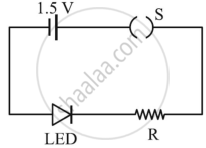
OR
iii. Draw V-I characteristic of a p-n junction diode in
(i) forward bias and (ii) reverse bias
Why a photo-diode is operated in reverse bias whereas the current in the forward bias is much larger than that in the reverse bias? Explain. Mention its two uses.
